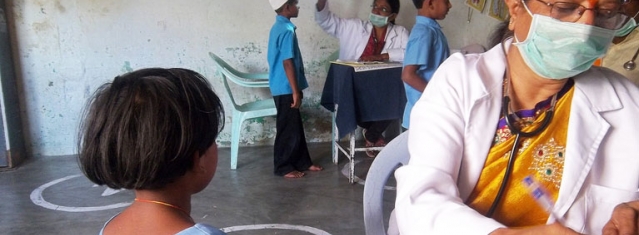News
ILO calls for urgent action to prevent looming global care crisis
Care work & jobs for the future of work

(Source: Trinity Care Foundation)
USPA NEWS -
Investment in the care economy needs to be doubled to avert a looming global care crisis, says a new ILO report.
Sweeping changes in policies should address the rising need for care and tackle the huge disparity between women´s and men´s care responsibilities. The figures show that women are performing more than three-quarters of the time spent in unpaid care work.
Sweeping changes in policies should address the rising need for care and tackle the huge disparity between women´s and men´s care responsibilities. The figures show that women are performing more than three-quarters of the time spent in unpaid care work.
Around 269 million new jobs could be created if investment in education, health and social work were doubled by 2030, the report says.
According to Care work and care jobs for the future of decent work , 2.1 billion people were in need of care in 2015, including 1.9 billion children under 15 and 200 million older persons. By 2030, this number is expected to reach 2.3 billion, driven by an additional 200 million older persons and children.
“The global prominence of nuclear families and single-headed households, and the growth of women´s employment in certain countries increase the demand for care workers. If not addressed properly, current deficits in care work and its quality will create a severe and unsustainable global care crisis and further increase gender inequalities in the world of work,“ said Laura Addati, lead author of the report.
According to Care work and care jobs for the future of decent work , 2.1 billion people were in need of care in 2015, including 1.9 billion children under 15 and 200 million older persons. By 2030, this number is expected to reach 2.3 billion, driven by an additional 200 million older persons and children.
“The global prominence of nuclear families and single-headed households, and the growth of women´s employment in certain countries increase the demand for care workers. If not addressed properly, current deficits in care work and its quality will create a severe and unsustainable global care crisis and further increase gender inequalities in the world of work,“ said Laura Addati, lead author of the report.
Data from 64 countries representing two thirds of the world´s working age population show that 16.4 billion hours per day are spent in unpaid care work ““ the equivalent to 2 billion people working eight hours per day with no remuneration. Were such services to be valued on the basis of an hourly minimum wage, they would amount to 9 per cent of global GDP or US$11 trillion (purchasing power parity in 2011).
Women bear the brunt of unpaid care work
According to the report, women perform 76.2 per cent of total hours of unpaid care work, more than three times as much as men.
In some countries, men´s contribution to unpaid care work has increased over the past 20 years. However, in the 23 countries providing such data, the gender gap in the time devoted to unpaid care responsibilities declined by just 7 minutes per day over the last two decades.
Women bear the brunt of unpaid care work
According to the report, women perform 76.2 per cent of total hours of unpaid care work, more than three times as much as men.
In some countries, men´s contribution to unpaid care work has increased over the past 20 years. However, in the 23 countries providing such data, the gender gap in the time devoted to unpaid care responsibilities declined by just 7 minutes per day over the last two decades.
“At this pace, it will take 210 years to close the gender gap in unpaid care work in these countries. The glacial rate of these changes calls into question the effectiveness of past and current policies in addressing the extent and division of unpaid care work over the past two decades,“ said Shauna Olney, Chief of the Gender, Equality and Diversity and ILOAIDS Branch of the ILO.
The report says that unpaid care work is the main barrier preventing women from getting into, remaining and progressing in the labour force. In 2018, 606 million working age women said that they were not able to do so because of unpaid care work. Only 41 million men said they were not in the labour force for the same reason.
The report says that unpaid care work is the main barrier preventing women from getting into, remaining and progressing in the labour force. In 2018, 606 million working age women said that they were not able to do so because of unpaid care work. Only 41 million men said they were not in the labour force for the same reason.
A 2017 ILO-Gallup report found that, globally, a majority of women would prefer to work at paid jobs, including those who are not in the workforce, and that men agree. It also found that the biggest challenges identified, by both women and men, for women who work at paid jobs was work-family balance and lack of affordable care. “This implies that a large number of women could be brought into paid employment through universal access to care policies, services and infrastructure,“ stressed Olney.
Need for increased spending on care
The report advocates a “˜high road´ to care work, which would result in a total of 475 million jobs by 2030, namely 269 million additional jobs compared with the number of jobs in 2015. This implies total public and private expenditure on care services of US$18.4 trillion or 18.3 per cent of total projected GDP. Such an investment would allow countries to reach several targets of four United Nations´ Sustainable Developments Goals (SDGs) by 2030: SDG 3 (health care for all), SDG 4 (education for all), SDG 5 (gender equality) and SDG 8 (decent work and economic growth).
Need for increased spending on care
The report advocates a “˜high road´ to care work, which would result in a total of 475 million jobs by 2030, namely 269 million additional jobs compared with the number of jobs in 2015. This implies total public and private expenditure on care services of US$18.4 trillion or 18.3 per cent of total projected GDP. Such an investment would allow countries to reach several targets of four United Nations´ Sustainable Developments Goals (SDGs) by 2030: SDG 3 (health care for all), SDG 4 (education for all), SDG 5 (gender equality) and SDG 8 (decent work and economic growth).
The report also showed that most care workers are women, frequently migrants and working in the informal economy under poor conditions and for low pay.
“A high road to care work means recognizing, reducing and redistributing unpaid care work and achieving decent work for care workers, including domestic and migrant workers. Poor job quality for care workers leads to poor quality care work. Our report calls for sweeping changes in care, macroeconomic, social protection, labour and migration policies,“ Addati concluded.
“A high road to care work means recognizing, reducing and redistributing unpaid care work and achieving decent work for care workers, including domestic and migrant workers. Poor job quality for care workers leads to poor quality care work. Our report calls for sweeping changes in care, macroeconomic, social protection, labour and migration policies,“ Addati concluded.
Other key findings:
* Mothers of children aged under 6 years suffer the highest “employment penalty“ with only 47.6 per cent of them in employment;
* unpaid carers also face a “job quality penalty“: Living with a child under 6 implies a loss of close to one hour of paid work per week for women and an increase in paid working time of 18 minutes per week for men;
* women with care responsibilities are more likely to be self-employed, to work in the informal economy and less likely to contribute to social security;
* attitudes towards the gender division of paid and unpaid care work are changing but the “˜male breadwinner´ family model remains very much engrained within societies, along with women´s caring role in the family continuing to be central;
* Mothers of children aged under 6 years suffer the highest “employment penalty“ with only 47.6 per cent of them in employment;
* unpaid carers also face a “job quality penalty“: Living with a child under 6 implies a loss of close to one hour of paid work per week for women and an increase in paid working time of 18 minutes per week for men;
* women with care responsibilities are more likely to be self-employed, to work in the informal economy and less likely to contribute to social security;
* attitudes towards the gender division of paid and unpaid care work are changing but the “˜male breadwinner´ family model remains very much engrained within societies, along with women´s caring role in the family continuing to be central;
* in 2016, only 42 per cent of countries out of 184 with available data met the minimum standards set out in the ILO Maternity Protection Convention No. 183 ;
* in the same year, 39 per cent of countries out of 184 with available data did not have any statutory leave provision for fathers (neither paid nor unpaid);
* globally, gross enrolment rates in early childhood services for children under 3 was only 18.3 per cent in 2015 and barely reached 57 per cent for children aged 3 to 6;
* long-term care services are close to non-existent in most African, Latin American and Asian countries.
* in the same year, 39 per cent of countries out of 184 with available data did not have any statutory leave provision for fathers (neither paid nor unpaid);
* globally, gross enrolment rates in early childhood services for children under 3 was only 18.3 per cent in 2015 and barely reached 57 per cent for children aged 3 to 6;
* long-term care services are close to non-existent in most African, Latin American and Asian countries.
Liability for this article lies with the author, who also holds the copyright. Editorial content from USPA may be quoted on other websites as long as the quote comprises no more than 5% of the entire text, is marked as such and the source is named (via hyperlink).






